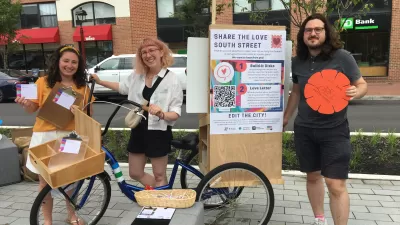Recently published research examines the "Role of Artificial Intelligence in Community Planning"—that is, the role of automated bots on social media in corrupting participatory planning processes.

New research published by the International Journal of Community Well-Being—written by Justin B. Hollander, Ruth Potts, Maxwell Hartt, and Miny Situ—examines the potential roles and risk of automated social media accounts to influence the community engagement components of planning processes.
Inherent to this investigation is an awareness of the growing awareness of land use development issues, as enabled by the Internet and its many social media platforms. As has been well documented with regard to issues of national and presidential politics, automated social media profiles can be deployed to corrupt the public discourse.
"Due to the low cost and high potential engagement, planners and policymakers have been quick to open electronic channels of participation to inform the decision-making process. Doing so has created an opportunity for subversion from groups with alternate and possibly nefarious interests," reads the abstract for the research.
In the process of reviewing the relevant literature, the paper reveals comes key terminology that defines the strategies of social bots (e.g., astroturfing, spamming, and Twitter bombs) that might be helpful in diagnosing the behavior and tenor of online accounts. Eventually the paper offers a list of mitigation strategies to help planners ensure that social bots don't overwhelm the public trust in planning processes.
The entire paper is available online via Springer.
FULL STORY: The Role of Artificial Intelligence in Community Planning

Study: Maui’s Plan to Convert Vacation Rentals to Long-Term Housing Could Cause Nearly $1 Billion Economic Loss
The plan would reduce visitor accommodation by 25,% resulting in 1,900 jobs lost.

North Texas Transit Leaders Tout Benefits of TOD for Growing Region
At a summit focused on transit-oriented development, policymakers discussed how North Texas’ expanded light rail system can serve as a tool for economic growth.

Why Should We Subsidize Public Transportation?
Many public transit agencies face financial stress due to rising costs, declining fare revenue, and declining subsidies. Transit advocates must provide a strong business case for increasing public transit funding.

How to Make US Trains Faster
Changes to boarding platforms and a switch to electric trains could improve U.S. passenger rail service without the added cost of high-speed rail.

Columbia’s Revitalized ‘Loop’ Is a Hub for Local Entrepreneurs
A focus on small businesses is helping a commercial corridor in Columbia, Missouri thrive.

Invasive Insect Threatens Minnesota’s Ash Forests
The Emerald Ash Borer is a rapidly spreading invasive pest threatening Minnesota’s ash trees, and homeowners are encouraged to plant diverse replacement species, avoid moving ash firewood, and monitor for signs of infestation.
Urban Design for Planners 1: Software Tools
This six-course series explores essential urban design concepts using open source software and equips planners with the tools they need to participate fully in the urban design process.
Planning for Universal Design
Learn the tools for implementing Universal Design in planning regulations.
Ascent Environmental
Borough of Carlisle
Institute for Housing and Urban Development Studies (IHS)
City of Grandview
Harvard GSD Executive Education
Toledo-Lucas County Plan Commissions
Salt Lake City
NYU Wagner Graduate School of Public Service





























